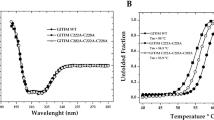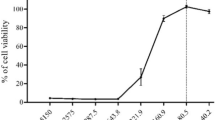Abstract
The protozoan Giardia lamblia is the most frequent intestinal parasite of first-world countries and a major cause of waterborne disorder often referred to as traveler’s diarrhea. We have previously noticed that the putrescine analog 1,4-diamino-2-butanone (DAB) remarkably inhibits the growth of anaerobic trichomonad and Trypanosoma cruzi parasites. Here, we examined the role of polyamines in Giardia cells using this putrescine analog. DAB impaired parasite proliferation dose-dependently. The analog induced increased flagella numbers and sometimes four ventral disks as well as asymmetrical division, indicating truncated or deregulated cytokinesis. Electron microscopy analysis revealed that DAB also triggered the encystment process. Oxidative stress was evaluated by measuring lipid peroxidation by thiobarbituric acid reactive substances (TBARS) detection. Trophozoites incubated either with 1 mM of DAB or putrescine for 18 h displayed increased lipoperoxide levels. Addition of 200 μM aminoguanidine, a polyamine/diamine oxidase inhibitor, partially reverted the DAB, but not the putrescine effects, indicating that the DAB effects are due, at least in part, to DAB oxidation end products. These data indicate that polyamines play a role in Giardia cell division, differentiation, and antioxidant defenses.




Similar content being viewed by others
Abbreviations
- DAB:
-
1,4-diamino-2-butanone
- AG:
-
aminoguanidine
- TBA:
-
thiobarbituric acid
- TBARS:
-
thiobarbituric acid reactive substances
References
Agostinelli E, Arancia G, Vedova LD, Belli F, Marra M, Salvi M, Toninello A (2004) The biological functions of polyamine oxidation products by amine oxidases: perspectives of clinical applications. Amino Acids 27:347–358
Ali SA, Hill DR (2003) Giardia intestinalis. Curr Opin Infect Dis 16:453–460
Bacchi CJ, Yarlett N (2002) Polyamine metabolism as chemotherapeutic target in protozoan parasites. Mini Rev Med Chem 2:553–563
Bacchi CJ, Garofalo J, Mockenhaupt D, McCann PP, Diekema KA, Pegg AE, Nathan HC, Mullaney EA, Chunosoff L, Sjoerdsma A, Hutner SH (1983) In vivo effects of alpha-dl-difluoromethylornithine on the metabolism and morphology of Trypanosoma brucei brucei. Mol Biochem Parasitol 7:209–225
Bansal D, Malla N, Mahajan RC (2006) Drug resistance in amoebiasis. Indian J Med Res 123:115–118
Bellé NA, Dalmolin GD, Fonini G, Rubin MA, Rocha JB (2004) Polyamines reduces lipid peroxidation induced by different pro-oxidant agents. Brain Res 1008:245–251
Benchimol M (2004a) Mitosis in Giardia lamblia: multiple modes of cytokinesis. Protist 155:33–44
Benchimol M (2004b) The release of secretory vesicle in encysting Giardia lamblia. FEMS Microbiol Lett 235:81–87
Bendesky A, Menendez D, Ostrosky-Wegman P (2002) Is metronidazole carcinogenic? Mutat Res 511:133–144
Berkman DS, Lescano AG, Gilman RH, Lopez SL, Black MM (2002) Effects of stunting, diarrhoeal disease, and parasitic infection during infancy on cognition in late childhood: a follow-up study. Lancet 359:564–571
Calvo-Méndez C, Villagomez-Castro JC, Lopez-Romero E (1993) Ornithine decarboxylase activity in Entamoeba invadens. Int J Parasitol 23:847–852
Campbell JD, Faubert GM (1994) Comparative studies on Giardia lamblia encystation in vitro and in vivo. J Parasitol 80:36–44
Chávez-Munguía B, Omaña-Molina M, González-Lázaro M, González-Robles A, Cedillo-Rivera R, Bonilla P, Martínez-Palomo A (2007) Ultrastructure of cyst differentiation in parasitic protozoa. Parasitol Res 100:1169–1175
Cook T, Roos D, Morada M, Zhu G, Keithly JS, Feagin JE, Wu G, Yarlett N (2007) Divergent polyamine metabolism in the Apicomplexa. Microbiology 153:123–130
Eckmann L, Laurent F, Langford TD, Hetsko ML, Smith JR, Kagnoff MF, Gillin FD (2000) Nitric oxide production by human intestinal epithelial cells and competition for arginine as potential determinants of host defense against the lumen-dwelling pathogen Giardia lamblia. J Immunol 164:1478–1487
Farthing MJ (2002) Tropical malabsorption. Semin Gastrointest Dis 13:221–231
Fernandez-Pinilla R, Pestana A (1987) Role of polyamines in proliferation and differentiation of Dictyostelium discoideum as ascertained by difluoromethylornithine treatment. Rev Esp Fisiol 43:439–443
Gavin IM, Glesne D, Zhao Y, Kubera C, Huberman E (2004) Spermine acts as a negative regulator of macrophage differentiation in human myeloid leukemia cells. Cancer Res 64:7432–7438
Ghosh S, Frisardi M, Rogers R, Samuelson J (2001) How Giardia swim and divide. Infect Immun 69:7866–7872
Giardino I, Fard AK, Hatchell DL, Brownlee M (1998) Aminoguanidine inhibits reactive oxygen species formation, lipid peroxidation, and oxidant-induced apoptosis. Diabetes 47:1114–1120
Gillin FD, Reiner DS, McCann PP (1984) Inhibition of growth of Giardia lamblia by difluoromethylornithine, a specific inhibitor of polyamine biosynthesis. J Protozool 31:161–163
Gillin FD, Reiner DS, Gault MJ, Douglas H, Das S, Wunderlich A, Sauch JF (1987) Encystation and expression of cyst antigens by Giardia lamblia in vitro. Science 235:1040–1043
Goldman P (1980) Metronidazole: proven benefits and potential risks. Johns Hopkins Med J 147:1–9
Gorowara S, Ganguly NK, Mahajan RC, Walia BN (1992) Study on the mechanism of Giardia lamblia induced diarrhoea in mice. Biochim Biophys Acta 1138:122–126
Hehl AB, Marti M (2004) Secretory protein trafficking in Giardia intestinalis. Mol Microbiol 53:19–28
Jung IL, Oh TJ, Kim IG (2003) Abnormal growth of polyamine-deficient Escherichia coli mutant is partially caused by oxidative stress-induced damage. Arch Biochem Biophys 418:125–132
Keister DB (1983) Axenic culture of Giardia lamblia in TYI-S-33 medium supplemented with bile. Trans R Soc Trop Med Hyg 77:487–488
Knodler LA, Schofield PJ, Edwards MR (1995) l-arginine transport and metabolism in Giardia intestinalis support its position as a transition between the prokaryotic and eukaryotic kingdoms. Microbiology 141:2063–2070
Knuutila S, Pohjanpelto P (1983) Polyamine starvation causes parallel increase in nuclear and chromosomal aberrations in a polyamine-dependent strain of CHO. Exp Cell Res 145:222–226
Kramer DL, Chang BD, Chen Y, Diegelman P, Alm K, Black AR, Roninson IB, Porter CW (2001) Polyamine depletion in human melanoma cells leads to G1 arrest associated with induction of p21WAF1/CIP1/SDI1, changes in the expression of p21-regulated genes, and a senescence-like phenotype. Cancer Res 61:7754–7762
Lanfredi-Rangel A, Attias M, Reiner DS, Gillin FD, De Souza W (2003) Fine structure of the biogenesis of Giardia lamblia encystation secretory vesicles. J Struct Biol 143:153–163
Lemée V, Zaharia I, Nevez G, Rabodonirina M, Brasseur P, Ballet JJ, Favennec L (2000) Metronidazole and albendazole susceptibility of 11 clinical isolates of Giardia duodenalis from France. J Antimicrob Chemother 46:819–821
Lengerich EJ, Addiss DG, Juranek DD (1994) Severe giardiasis in the United States. Clin Infect Dis 18:760–763
Lloyd D, Ralphs JR, Harris JC (2002) Giardia intestinalis, a eukaryote without hydrogenosomes, produces hydrogen. Microbiology 148:727–733
Lujan HD, Mowatt MR, Byrd LG, Nash TE (1996) Cholesterol starvation induces differentiation of the intestinal parasite Giardia lamblia. Proc Natl Acad Sci USA 93:7628–7633
Maeda T, Wakasawa T, Shima Y, Tsuboi I, Aizawa S, Tamai I (2006) Role of polyamines derived from arginine in differentiation and proliferation of human blood cells. Biol Pharm Bull 29:234–239
Martinez-Pacheco M, Rodriguez G, Reyna G, Calvo-Mendez C, Ruiz-Herrera J (1989) Inhibition of the yeast-mycelial transition and the phorogenesis of Mucorales by diamino butanone. Arch Microbiol 151:10–14
Menezes D, Valentim C, Oliveira MF, Vannier-Santos MA (2006) Putrescine analogue cytotoxicity against Trypanosoma cruzi. Parasitol Res 98:99–105
Muller S, Coombs GH, Walter RD (2001) Targeting polyamines of parasitic protozoa in chemotherapy. Trends Parasitol 17:242–249
Nanda N, Michel RG, Kurdgelashvili G, Wendel KA (2006) Trichomoniasis and its treatment. Expert Rev Anti Infect Ther 4:125–35
Nash TE (2001) Treatment of Giardia lamblia infections. Pediatr Infect Dis J 20:193–195
Partovi F, Khalili G, Kariminia A, Mahmoudzadeh-Niknam H (2007) Effect of Giardia lamblia infection on the cognitive function of school children. Iranian J Publ Health 36:73–78
Petri WA Jr (2000) Protozoan parasites that infect the gastrointestinal tract. Curr Opin Gastroenterol 16:18–23
Pietila M, Pirinen E, Keskitalo S, Juutinen S, Pasonen-Seppanen S, Keinanen T, Alhonen L, Janne J (2005) Disturbed keratinocyte differentiation in transgenic mice and organotypic keratinocyte cultures as a result of spermidine/spermine N-acetyltransferase overexpression. J Invest Dermatol 124:596–601
Reiner DS, Hetsko ML, Das S, Ward HD, McCaffery M, Gillin FD (1993) Giardia lamblia: absence of cyst antigens and reduced secretory vesicle formation and bile salt uptake in an encystation-deficient subline. Exp Parasitol 77:461–472
Reis IA, Martinez MP, Yarlett N, Johnson PJ, Silva-Filho FC, Vannier-Santos MA (1999) Inhibition of polyamine synthesis arrests trichomonad growth and induces destruction of hydrogenosomes. Antimicrob Agents Chemother 43:1919–1923
Rider JE, Hacker A, Mackintosh CA, Pegg AE, Woster PM, Casero RA Jr (2007) Spermine and spermidine mediate protection against oxidative damage caused by hydrogen peroxide. Amino Acids 33:231–240
Sagolla MS, Dawson SC, Mancuso JJ, Cande WZ (2006) Three-dimensional analysis of mitosis and cytokinesis in the binucleate parasite Giardia intestinalis. J Cell Sci 119:4889–4900
Savioli L, Smith H, Thompson A (2006) Giardia and Cryptosporidium join the ‘Neglected Diseases Initiative’. Trends Parasitol 22:203–208
Schofield PJ, Costello M, Edwards MR, O'Sullivan WJ (1990) The arginine dihydrolase pathway is present in Giardia intestinalis. Int J Parasitol 20:697–699
Schofield PJ, Edwards MR, Matthews J, Wilson JR (1992) The pathway of arginine catabolism in Giardia intestinalis. Mol Biochem Parasitol 51:29–36
Schupp DG, Januschka MM, Sherlock LA, Stibbs HH, Meyer EA, Bemrick WJ, Erlandsen SL (1988) Production of viable Giardia cysts in vitro: determination by fluorogenic dye staining, excystation, and animal infectivity in the mouse and Mongolian gerbil. Gastroenterology 95:1–10
Scott KG, Meddings JB, Kirk DR, Lees-Miller SP, Buret AG (2002) Intestinal infection with Giardia spp. reduces epithelial barrier function in a myosin light chain kinase-dependent fashion. Gastroenterology 123:1179–1190
Soška V, Olšovský J, Zechmeister A, Lojek A, Bouda J, Garcia Escamilla RM (1997) Free oxygen radicals and lipoperoxides in type II (non-insulino-dependent) diabetic patients. Revista Mexicana de Patologia Clinica 44:62–66
Stimac E, Morris DR (1987) Messenger RNAs coding for enzymes of polyamine biosynthesis are induced during the G0-G1 transition but not during traverse of the normal G1 phase. J Cell Physiol 133:590–594
Sunkara PS, Rao PN, Nishioka K, Brinkley BR (1979) Role of polyamines in cytokinesis of mammalian cells. Exp Cell Res 119:63–68
Sunkara PS, Ramakrishna S, Nishioka K, Rao PN (1981) The relationship between levels and rates of synthesis of polyamines during mammalian cell cycle. Life Sci 28:1497–1506
Sunkara PS, Chang CC, Prakash NJ (1983) Role of polyamines during chromosome condensation of mammalian cells. Cell Biol Int Rep 7:455–465
Tabor CW, Tabor H (1976) 1,4-Diaminobutane (putrescine), spermidine, and spermine. Annu Rev Biochem 45:285–306
Tabor CW, Tabor H (1984) Polyamines. Annu Rev Biochem 53:749–790
Taylor JL, Turo KA, McCann PP, Grossberg SE (1988) Inhibition of the differentiation of 3T3-L1 cells by interferon-beta and difluoromethyl ornithine. J Biol Regul Homeost Agents 2:99–104
Tkachenko AG, Nesterova LY (2003) Polyamines as modulators of gene expression under oxidative stress in Escherichia coli. Biochemistry (Mosc). 68:850–856
Tkachenko AG, Pshenichnov MR, Nesterova LY (2001) Putrescine as a oxidative stress protecting factor in Escherichia coli. Mikrobiologiia 70:487–494
Turrens JF (2004) Oxidative stress and antioxidant defenses: a target for the treatment of diseases caused by parasitic protozoa. Mol Aspects Med 25:211–220
Upcroft P, Upcroft JA (2001) Drug targets and mechanisms of resistance in the anaerobic protozoa. Clin Microbiol Rev 14:150–164
Yarlett N (1988) Polyamine biosynthesis and inhibition in Trichomonas vaginalis. Parasitol Today 4:357–360
Acknowledgments
We acknowledge the valuable technical assistance of Claudio Pereira Figueira and secretarial assistance of Elisângela Sodré. WS, MFO, and MAVS are CNPq research fellows. All the experiments reported here comply with Brazilian laws and norms of the Health Ministry.
This study is supported by TDR, FIOCRUZ, CNPq, PROCAD/CAPES, FAPESB.
Author information
Authors and Affiliations
Corresponding author
Rights and permissions
About this article
Cite this article
Maia, C., Lanfredi-Rangel, A., Santana-Anjos, K.G. et al. Effects of a putrescine analog on Giardia lamblia . Parasitol Res 103, 363–370 (2008). https://doi.org/10.1007/s00436-008-0981-9
Received:
Accepted:
Published:
Issue Date:
DOI: https://doi.org/10.1007/s00436-008-0981-9




